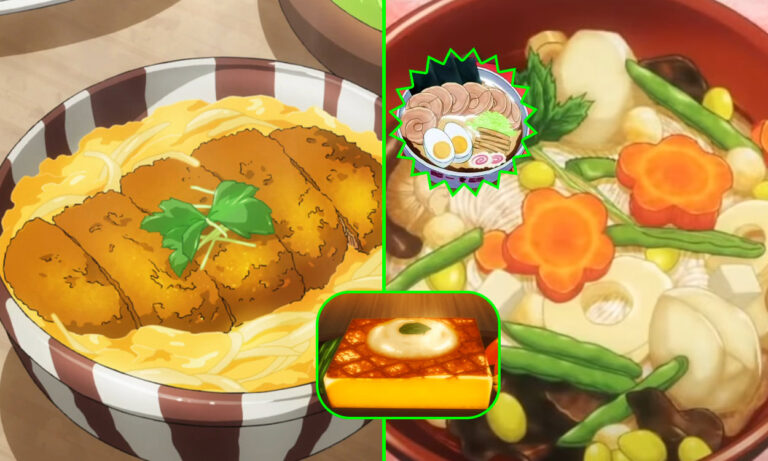A search for perfection: Why does the food in anime look so tasty?

In anime, food appears at its best—almost an exaggerated three-dimensional version of itself that reflects upon, explores and explains the nuances of Japanese life with incredible accuracy and detail. Though it’s hard to pinpoint exactly what makes these animations so appealing in the first place, that’s exactly what we’ll aim to do in this piece.
Over on Instagram, accounts like @anime_food post screenshots of the rich range of mouth-watering meals seen across different styles of anime, while others such as @en93kitchen turn infamous delicacies seen in the animation genre into picture-perfect edible treats. This social media buzz is one of the many factors that’s creating a culture of anime foodies across the globe.
Anime food’s celebrity fanbase is also helping cement its cultural clout. The likes of BTS, Ariana Grande, Megan Thee Stallion, Quentin Tarantino and Michael B. Jordan are all aficionados, which is further spearheading the niche’s borderless appeal. As it moves from an under-the-radar genre to being accepted on a global scale, anime food has become the star of the show and the main attraction.
“The connection between anime and food is captivating because it allows viewers to experience different cultures, connect with their favourite characters, and create a sensory experience that feels almost real,” Andu Ava, co-founder and CEO of manga and anime-themed restaurant Uzumaki London, told SCREENSHOT.
Anime food is ushering in new ways of thinking about and relating to food in popular culture, and it’s satiating people’s appetites, in turn welcoming in a new era of anime fans and food connoisseurs in the process.
“If a certain food becomes integral to a certain anime’s storyline, fans will want to experience the same food as their favourite anime character,” explained KC, General Manager for the Singapore-based independent art studio Collateral Damage Studios. “It’s like getting closer to someone they idolise.”
@nikatyl #anime #food #blacksunsquad #sayosquad#mondaijisquad #sakanasquad
♬ เสียงต้นฉบับ - Nikatyl07 - Nikatyl07
The immersive nature of anime and its ability to make anything and everything look hyper-realistic, especially food, almost as if you can reach out and taste what you see on-screen, is allowing audiences to not only identify with their favourite characters but also imagine what life is like in the ‘animeverse’. In a world that’s often all doom and gloom, food-based anime content is joyful and soothing to watch.
“By showcasing detailed animations and close-up shots of the food, viewers can imagine themselves actually eating and enjoying it,” Ava told me. “This creates a strong connection between the viewer and the anime, making the experience more enjoyable and memorable.”
Steaming bowls of ramen are given an alluring shine in Muteki Kanban Musume, onigiri is wrapped in a velvety layer of seaweed in Pokémon, takoyaki has an irresistible lustre in Takoyaki Mantoman and taiyaki have just the right amount of glaze in My Hero Academia and Kanon. The food in anime depicts everyday setups and scenarios with a huge amount of detail and care, leading infamous dishes to become popular both on and off-screen.
“Anime fans are known to patronise restaurants that are featured within anime and order the same dish as their favourite characters,” says KC. Whether that’s hunting down anime food at street food markets, small hole-in-the-wall joints or well-known restaurant chains, anime enthusiasts have found that delicacies taste better when they get to try them for themselves.
“At Uzumaki London, we are passionate about bringing the world of anime food to life. We have seen a growing interest from our audiences in seeking out the food they see on-screen, and we provide a unique dining experience that caters to anime fans’ cravings,” Ava explained.
Lovers of the predominantly hand-drawn animations are hunting down ebi fry, giant-like fried shrimp rolled in breadcrumbs as seen in Sailor Moon and Restaurant to Another World. They’re tucking into anpan, a Japanese roll filled with sweet red bean paste that features in the anime series Anpanman, and they’re cleaning their plates eating katsudon, a pork cutlet rice bowl, the same way figure skater Yuri Ktasuki does in Yuri On Ice, in order to get closer to the content they love to watch.
“Another important function of food in anime, as exemplified in Naruto, is that it makes characters more relatable to the audience. Naruto’s love of ramen and his enjoyment of food in general are aspects of his personality that many viewers can relate to,” explains Ava. “It humanises him and makes him more approachable.”
@anndew12099 #anime #food #wallpaper 🥓🥚🍞
♬ เสียงต้นฉบับ - 𝓐𝓷𝓷𝓓𝓮𝔀𝔃🍀 - 𝓐𝓷𝓷𝓓𝓮𝔀𝔃🍀
Anime communities worldwide are widening their palates by watching these shows, but they’re also looking for ways to embed themselves in Japanese society and culture at large. “Anime and manga have played a significant role in introducing Japanese cuisine and culture to a wider global audience, particularly among millennials and gen Z,” says Ava.
“The depiction of food in anime is not just about showcasing the dishes themselves but also the cultural significance of food in Japan. Food is often used in [the animation genre] to strengthen relationships and build up strength for the next adventure,” he adds.
Beyond food, it’s the cultural significance and immersion into unfamiliar territory that’s keeping fans so engrossed in the genre that they continue to come back for more.
Experimental cuisine is also very much flavour of the month and on the anime menu. In Food Wars!: Shokugeki no Soma, an anime series that follows students at a fine dining academy battling it out at a cooking tournament, Western dishes such as hamburgers and beef stew are reinvented and star alongside traditional Japanese cuisines such as bento boxes and ramen.
It’s this combination of old world and new world, traditional and non-traditional, expected and unexpected that’s deepening people’s love of the genre while opening their eyes to the ingenuity and diversity of anime cuisine.
The food in anime is just as memorable as anything else, if not more so. “Anime characters have their own favourite foods and unique eating habits that serve to make them more relatable to the audience, creating a deeper emotional connection between viewers and the characters they love,” explains Ava.
Driven by a hunger for novelty, newness and relatability, anime food is compelling and doesn’t disappoint. Whether old or new, from Japan or outside of it, anime food is appealing because it’s become a genre all of its own. Anime food is the moment, and it’s here to stay.





